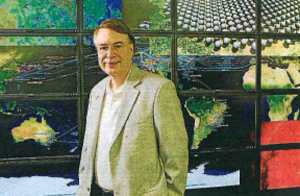Call for Ultra-Fast Network
CMelbourne and San Diego, Oct. 12, 2008 -- On a tour of Australian universities, Calit2 Director Larry Smarr is "to lobby Canberra to invest in the OptIPortal network," according to Monday's issue of the weekly Australian Financial Review, in a story titled "Call for ultra-fast network.".
|
Separately, the Chancellor of Australia's Monash University recently witnessed a high-definition videoconference from Calit2 at UC San Diego [Windows Media player required] -- and came away impressed. Writing in his October 2008 message to the university, Dr. Alan Finkel is convinced that the technology will change the future of research and education, and notes the close ties between Monash and UC San Diego thanks to the Pacific Rim Experiences for Undergraduates (PRIME) program that is funded by the National Science Foundation with additional support from the UCSD division of Calit2. Following is Finkel's October message, which coincides with Calit2 Director Larry Smarr's current visit to Australian universities to talk up the importance of ultra-broadband networking to remain competitive in the global research marketplace:
|
“I have seen the future, and it is now,” said Nam June Paik, the Korean artist who invented video art.
I attended a seminar held by the IT faculty in September. In all respects but one it was what you would expect. The title was suitably academic: Multi-Scale Modelling of the Heart. The content was extensive, describing computer models that ranged in scale from the microscopic proteins comprising a model of individual heart cells to electrical and mechanical models of the entire heart and torso. The models ranged in temporal scale from the microseconds required for protein reactions to the hours and days required for evolving pathologies.
The computer-generated images and animations were superb, the lecturer was unmistakably an expert. The audience was deeply attentive, all the more so because the lecturer made consistent eye contact with his audience. The lecturer, Andrew McCulloch, was clearly aware of our interest and it energised his delivery.
What made this seminar strikingly unusual, though, was the fact that Andrew McCulloch was standing at a podium in a room at the University of California, San Diego , while we were seated in an office of the Faculty of Information Technology at the Clayton campus in Victoria. McCulloch’s lecture and slides were beamed to us at high-definition television resolution. At the same time, a camera at our end sent him a continuous view of the audience in Clayton. A series of microphones at our end dangled from the ceiling like electronic stalactites to pick up questions from the audience. The sound quality was superb.
I’ve participated in numerous video conferences to date but nothing like this. The quality was so high that the experience was almost as if we were all in the same room. How was this achieved? By the use of an ultra high-speed communications link implemented via the Australian Academic and Research Network (AARNet). For the technically minded, this particular seminar used a bidirectional 140 megabits-per-second link.
There was nothing fundamentally different in concept about this video connection to others that have been in use for 30 years. Nevertheless, to me it was ground-breaking. Why? Because the massively increased bandwidth was transformational. Quantity begat quality.
Andrew McCulloch collaborates with Professor David Abramson (BSc(Hons) 1979, PhD 1983) at Monash. Under an existing exchange program, the University of California at San Diego sends students to do research in Australia during the northern summer break. Between visits, they rely on electronic communication to share data and to work with their co-supervisors. Soon, under a new exchange program, Monash University students will be able to spend the southern summer break in America. Similar programs are springing up between other countries.
The future is here, at least for some. High-speed communication will impact research and education. It will also have a major influence on industrial-scale collaborations in multimedia and medicine. Further, it will enable long-distance social interactions at an unprecedented level. My experience in this seminar certainly argues the case for very high-speed broadband to be made available to every Australian business and home.
I was pleased to see that Monash is pioneering the use of technology to underpin international collaborations. This is not an isolated case – seminars such as this one are sponsored by the Monash eResearch Centre. Such international collaborations are consistent with our international identity that makes us unique among universities and positions us well to provide the kind of education our students need to work in a global environment.
Related Links


